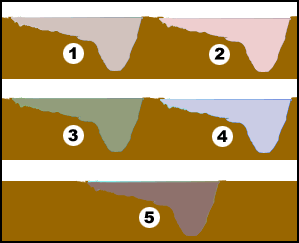|
|

|
 |
 | ||
Water Color Affects Fishing Success
Most fishermen have the wrong idea about "good-looking" water. They see a crystal clear lake and the reaction is "Oh boy! Look at that beautiful fishing water." Nothing could be more wrong. In the study of water color, we approach it in terms of light. We should think about how much light penetrates the water. The more light penetration, the worse the fishing conditions. The less the light penetration, the better the fishing. Clear water means deep fish, short migrations, more weed and moss growth, and usually more water skiers. It means more of everything that spells trouble for fishermen. The more dingy, cloudy, or darker the water, the better the conditions for fishing. We need to pay as much attention to water color as anything. We are not saying that clear water does not contain fish. We are saying that water color will affect how deep the fish are, and just how shallow they come, and how long they stay in the shallows. It will affect how many fish we catch. Let's rank the various water colors we will encounter. We put water color into five categories in order of "goodness" when fishing. The best water color gives the best fish movements and greatly increases our chances of fishing success.
Natural lakes which are spring fed (landlocked) are usually clear. They may turn a yellow green due to algae growth in the summer. Natural lakes fed by streams can be darker, such as during the spring when colored waters feed into the lake. Reservoirs are normally more influenced by stream inflows and runoff, especially during spring. In a reservoir there is usually a color variation between the headwaters (darker, less light penetration) to the dam area (usually clearer water). Large lakes and reservoirs typically display various colors from one area to another and we can help our chances for fishing success by fishing where the water color gives us an advantage. Weeds vs. Water Color Water color also determines the amount of weed growth. The clearer the water, the greater the weed growth, If the water is extra clear, weeds could go as deep as 15-20 feet, with moss going down to even greater depths. If the water is clear (not extra clear) weeds could go to 12-14 feet. In lighter yellow-green lakes, weed growth can go down to 8-10 feet. While in darker yellow-green, weed growth goes only to around 6-7 feet. When you get into red-sandy or white-sandy you can forget about a weed situation. In polluted waters weed growth can run wild. By noting the extent of the weeds you can get an indication of the fishing potential of any water. If weed conditions are excessive, good fishing will be tough. If the weed condition is a small one, good fishing should be easy. Migration vs. Water Color  Water color affects fish migration on a structure. Note figures 1, 2, and 3. They are identical situations with the exception of water color. Figure 1 is clear water. Figure 2 is a darker yellow-green. Figure 3 is white-sandy. Note the weedline depths. In clear water weeds extend to 14 feet. In yellow-green to 7 feet. In white sandy there are no weeds. We also show an average migration of fish as a comparison. Note the fish depth in each situation. Fish in the clear water have moved to the 30 foot dropoff. Those in the yellow green water are now up to the rock pile. Those in the white-sandy are at the stump with a couple fish scattering into the shallows. The other item affected by water color is the time of migration and the amount of fish activity. The clearer the water, the less the activity and the less time you have to make a catch. To increase your overall fishing success, pick lakes and rivers and areas in lakes and rivers where water color can give you a fishing advantage. #### |
|
|
| Site design by Outdoor Management Network Inc. Copyright © 1996 - 2007 Outdoor Management Network Inc. America Outdoors® is a registered trademark of Outdoor Management Network Inc. |
 As fishermen, we will find that water color has a greater effect
on the degree of our fishing success, or failure than any other
water condition.
As fishermen, we will find that water color has a greater effect
on the degree of our fishing success, or failure than any other
water condition. From best to worst:
From best to worst: